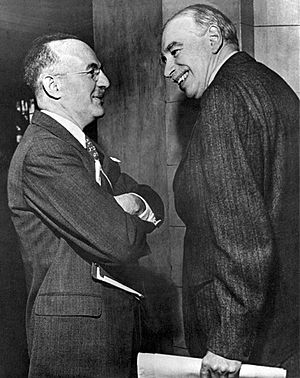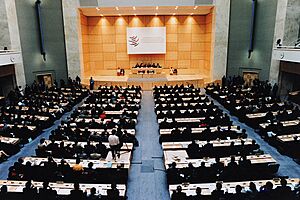History of the World Trade Organization facts for kids

The World Trade Organization (WTO) is an important group that helps manage international trade between countries. It officially started on January 1, 1995. This happened after 123 nations signed the Marrakesh Agreement in 1994. The WTO took over from an older agreement called the General Agreement on Tariffs and Trade (GATT), which began in 1948.
The WTO's main job is to set up rules for trade between its member countries. It helps countries talk about trade agreements and solves problems when countries disagree. This makes sure everyone follows the rules they agreed upon. Most of the WTO's rules come from past trade talks, especially the Uruguay Round from 1986 to 1994.
The WTO's older version, the GATT, was created after World War II. It was part of a bigger plan to help countries work together on money and trade. Other groups like the World Bank and the International Monetary Fund were also formed around this time. There was a plan for a group called the International Trade Organization (ITO). It would have dealt with many trade-related issues. However, the ITO treaty was never fully approved, so it didn't start.
Because the ITO didn't happen, the GATT became the main international group for trade. It worked for almost 50 years before the WTO was created.
Contents
GATT: How Trade Rules Evolved
The GATT was the only big agreement guiding international trade from 1946 until the WTO began in 1995. For nearly half a century, GATT worked as a temporary agreement. During this time, countries held eight major talks, called "rounds," to improve trade rules.
Early Trade Talks: From Geneva to Tokyo
The first GATT trade rounds focused on lowering tariffs. Tariffs are like taxes on goods coming into a country. Later, the Kennedy Round in the 1960s added rules against dumping. Dumping is when a country sells goods in another country at a very low price. This round also included rules to help developing countries.
The Tokyo Round in the 1970s was a big step. It tried to deal with trade barriers that weren't tariffs. These are called non-tariff barriers. This round created new agreements to improve the trade system. Some of these agreements were later updated and became rules for all WTO members.
Uruguay Round: A Major Change for Global Trade
By the 1980s, the GATT system needed to change to fit the new global economy. In September 1986, the eighth GATT round, known as the Uruguay Round, began in Punta del Este, Uruguay.
This was the biggest trade negotiation ever. The talks expanded trade rules into new areas like services and intellectual property. They also aimed to reform trade in important areas like farming and textiles. All the original GATT rules were reviewed.
The final agreement of the Uruguay Round was signed on April 15, 1994, in Marrakesh, Morocco. This agreement officially created the WTO. It is known as the Marrakesh Agreement.
The original GATT still exists as part of the WTO's rules for trading goods. It was updated by the Uruguay Round and is now called GATT 1994. The Marrakesh Agreement included about 60 other agreements and decisions. These agreements cover six main areas:
- The agreement that created the WTO.
- Rules for goods and investments, including GATT 1994.
- Rules for services, called the General Agreement on Trade in Services (GATS).
- Rules for intellectual property, like patents and copyrights, called the Agreement on Trade-Related Aspects of Intellectual Property Rights (TRIPS).
- A system for solving trade disagreements.
- A way to review countries' trade policies.
The Uruguay Round was successful in getting more countries to agree to "bind" their tariffs. This means they promised not to raise tariffs above a certain level. This helped make trade more predictable.
Ministerial Conferences: Where Decisions Are Made

The most important decision-making group in the WTO is the Ministerial Conference. It usually meets every two years. All WTO members, which are countries or groups of countries, attend these meetings. The Ministerial Conference can make decisions on any matter covered by the WTO's trade agreements.
- The first conference (1996) was held in Singapore. Here, disagreements came up between richer and developing countries. These issues became known as the "Singapore issues."
- The second conference (1998) was in Geneva, Switzerland.
- The third conference (1999) in Seattle, Washington, did not go well. There were large protests, which drew worldwide attention.
- The fourth conference (2001) was in Doha, Qatar. Here, the Doha Development Round of talks began. China also joined the WTO at this meeting, becoming the 143rd member.
- The fifth conference (2003) was in Cancún, Mexico. Countries tried to agree on the Doha round issues. However, a group of 22 developing countries, led by India, China, and Brazil, resisted demands from richer countries. They also asked for an end to agricultural subsidies in the EU and the US. Subsidies are payments that help farmers. The talks broke down without progress.
- The sixth conference (2005) was in Hong Kong. This meeting was very important for the Doha Development Round. Countries agreed to stop all their agricultural export subsidies by the end of 2013. They also agreed to end cotton export subsidies by the end of 2006. Developing countries also got some benefits, like duty-free access for goods from the poorest countries.
In 2009, the WTO held another conference in Geneva. This meeting was mainly to catch up on regular meetings that had been missed. It focused on open discussions rather than new negotiations.
Doha Round: Helping Developing Countries
The WTO started its current round of talks, the Doha Development Round, in November 2001 in Doha, Qatar. This was a big effort to make globalization fairer and help poorer countries. A main goal was to reduce barriers and subsidies in farming. The talks aimed for more open trade and new rules. They also promised to give more help to developing countries.
These negotiations have been difficult. There are still disagreements over key areas, especially farm subsidies. For example, in 2008, a meeting failed because countries couldn't agree on how to protect farmers from sudden increases in imports. The European Union believes that finishing the Doha talks would show that global trade rules are important. It would also help the WTO protect against countries trying to block trade.
As of 2013, an agreement had not been reached, despite many meetings. The talks continue to be challenging.

